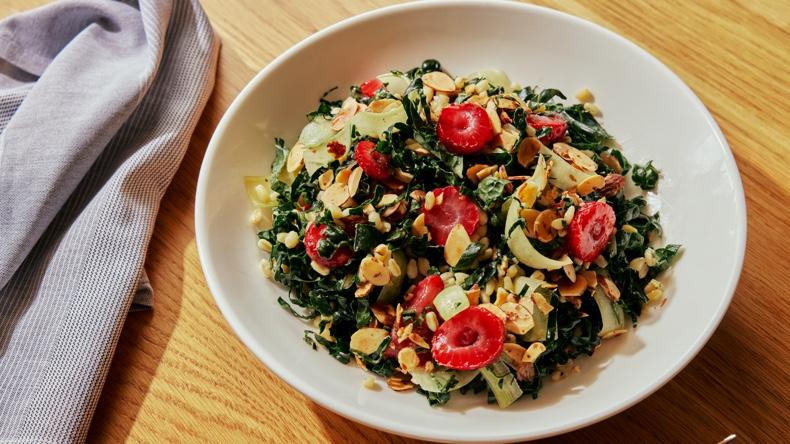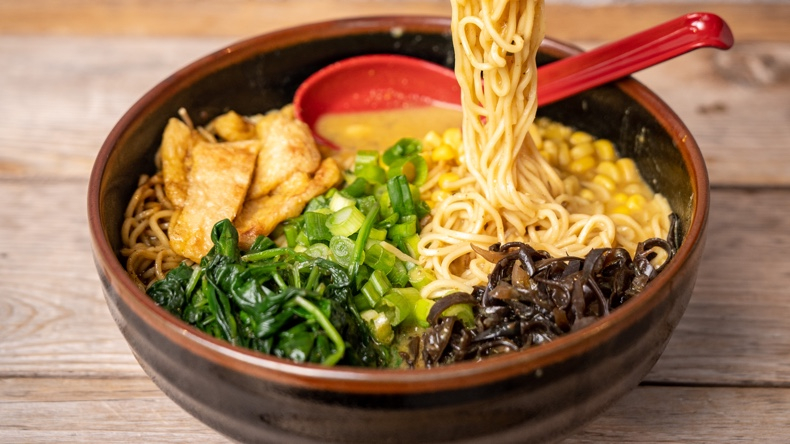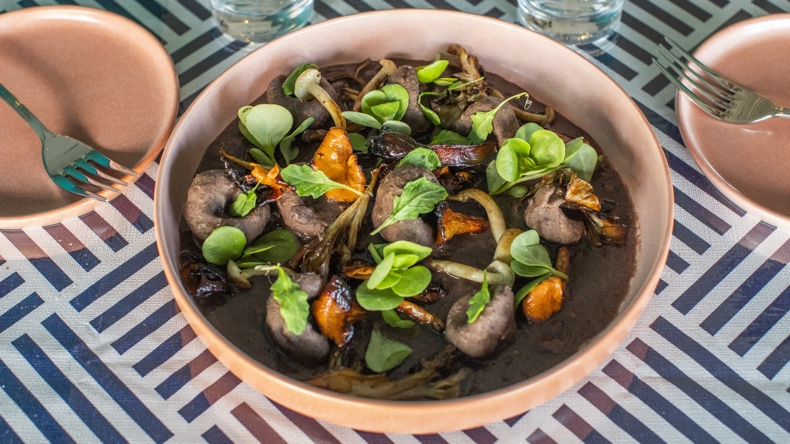Food
These Five Vegan Dishes Have Withstood the Test of Time
The growing demand for vegan items might make it tempting to reach for texturized vegetable protein or a kitchen sink veggie burger for your next meat-free addition, but we suggest looking to the past for simple and time-tested dishes that are easily adapted for modern menus. From Ethiopian shiro wat to heirloom corn masa dumplings and ramen made vegan with an almond-paste base, we rounded up five dishes that have proven their plant-based staying power.
Mushroom Kalguksu
Naro, New York City
Nate Kuester was the chef de cuisine at New York City’s Atoboy for almost two years when chef/owner JP Park approached him about Naro, a restaurant that would highlight the subtle flavors of Korean cuisine. “Not what you find in mainstream Korean restaurants, which are often big, spicy, sweet flavors,” says Kuester. “We started pulling inspiration from as late as the Joseon Dynasty.” One dish was kalguksu, a knife-cut noodle soup published in a 1670 cookbook, a time when noodles were served as a special occasion dish. Now a Seoul street food staple, Kuester and Park made a vegan version for their vegetarian tasting menu. “I’m a Korean adoptee, so trying to find something old and make it new was a great challenge,” he says. It starts with the noodle, a mixture of wheat flour, potato starch, and sweet rice flour they buy from a Korean purveyor. They boil the noodles (sans salt) for four minutes and start with a twirl on the plate. They add pan-roasted oyster mushrooms, and kabocha squash that’s shaved, steamed, dressed in cold-pressed sesame oil, and punched with a flower-shaped cutter à la minute. Peeled white button mushrooms and marigold petals are added to the bowl that gets a tableside pour of doenjang broth made with dashi, jalapeños, dried pyogos (shiitake mushrooms), Yondu vegetable extract, gochugaru, chile flakes, and perilla seed powder. A mix of palate-zapping chopi and kabocha squash powder goes on top. “We wanted to preserve everything we liked about kalguksu, but make it our own,” Kuester says.

Kale Tabouli
Galit, Chicago
Tabouli salad is said to have originated in Lebanon 4,000 years ago, and the vegan bulgur-herb salad is still ripe for reinvention. At Chicago’s Galit, it’s shown up as a tomato- and green onion-heavy Turkish version prepared for family meal, as well as Chef Zach Engel’s seasonal version from the opening à la carte menu. “We were heading into late fall, and I had never cooked in Chicago before. A sous chef told me to take advantage of any produce we had during a very short window,” says Engel, who mixed delicata squash and apples with bulgur wheat, swapped the herbs for kale, and added a lemon-garlic vinaigrette and Baharat-spiced pepitas (recipe), a nod to a salad his wife makes. “I thought about how to have the same flavor profile but turn it into a tabouli, which I prefer to be more herb- than bulgur-heavy.” To get the grain to the right consistency, he adds hot water and salt, covers it in plastic wrap, and lets it sit until fully absorbed for two hours. “We fluff it with a fork on a tray to evaporate the steam so it doesn’t get waterlogged, and let it drain over a towel. If you don’t get enough water off, it can turn into a paste or get gummy.” Engel’s summer tabouli swaps in lovage-pickled green strawberries, celery, and almonds, but he keeps the same kale/bulgur combo and dressing (recipe).

Nu Skool Vegan Ramen
Ramen-Tatsu-Ya, Austin
One of Takuya “Tako’’ Matsumuto’s first cooking jobs was at a holistic spa in Austin, Texas, where he had to accommodate Atkins diets, vegans, and guests following strict fasts. “People wanted an omelet made with 20 egg whites for dinner. They saw food as fuel, which was boring and sad, because when I eat, I can get emotional,” says Matsumuto. In 2012 he and Tatsu Aikawa, friends and fellow DJs, teamed up to open a ramen shop. Despite the Texas heat, they were busy from the get-go, with a rich tonkotsu pork ramen as their “bread and butter.” To accommodate vegetarians, they offered vegan ramen on Sundays. The demand became so high they added it to the menu, and three iterations later, they offer two veggie ramens at all seven locations. After experimenting with a few vegan versions of meaty tonkotsu broth, they nailed the same rich and thick consistency with almond paste. “Every bowl of ramen needs broth, flavored oil, or fat,” he says. They make a mushroom oil and add garlic, spinach, scallions, blanched corn, and tofu skin that’s rested in a miso marinade and seared. “The skin sucks up the broth and adds texture,” says Matsumuto, who adds more wood ears for a soft crunch. The spicy version of the Nu Skool includes their proprietary curry spice blend. “It’s about the love and care that goes into soup. It should be like a nice warm hug, whether it’s vegetarian or not,” he says.

Shiro Wat
Berbere, Santa Monica, Calif.
“Shiro is the closest to my heart,” says Chef/Owner Tezeta “Tete” Alemayehu of the Ethiopian chickpea stew. “I would be happy eating it every day. It’s served in every Ethiopian home whether you have money or not.” She learned to make the dish from her grandmother and says the silky, bright orange stew is an underrated, protein-rich staple of the Ethiopian diet, especially for the country’s orthodox Christians who historically eat vegan dishes during religious fasts. At her organic, vegan restaurant Berbere, Alemayehu serves bubbling bowls of shiro in clay pots with injera and tomato salad. The base relies on housemade chickpea flour for which she soaks chickpeas overnight, roasts them for 15 to 20 minutes at 3500F until crunchy, and then blends them into a flour consistency. She adds berbere spice (a blend of fenugreek, cardamom, rosemary, and other warm spices), chile powder, and a pinch of turmeric. To make the stew, she sautées garlic in olive oil until fragrant (fresh diced tomatoes and red onion would also traditionally be added to the sauté, but she omits them to accommodate guest allergies), adds 1 cup of the floury mixture to 2 cups hot water, mixes to break up clumps, and brings to a boil. “It’s like making oats. Cover and simmer for 15 to 20 minutes until it thickens and turns into a creamy consistency,” she says. A jalapeño garnish adds color and heat. “I love my grandma so much. I still remember the taste of her shiro. It reminds me of togetherness as a family, and the way we eat back home,” she says.

Joloches con Hongo
El Molino, St. Louis
Whether you know them as orejitas (Iittle ears) or ombligitos (little belly buttons), the bialy-esque indentation of joloches, or Yucatán corn masa dumplings, is more than just a cute shape. It’s meant to help with even cooking. It’s not something Chef Alex Henry thought about as a kid from the Yucatán capital of Mérida. “It was comfort food,” he says of the dumplings he ate at his grandmother’s. At El Molino, Henry now serves a vegan version. To make the dumplings, he nixtamalizes White Henry Moore corn for its soft fluffy texture, and augments the masa with vegetable shortening instead of lard. “They traditionally aren’t served with meat, but they are cooked with lard, and it seemed like an easy omission,” says Henry. For the base of the plate, he makes twice-cooked frijoles colados seasoned with epazote (an essential Yucatán flavor), onion, and habanero. He tops the beans with the boiled dumplings and lime-marinated, plancha-seared oyster and lion’s mane mushrooms, which he dusts with powdered fermented mushroom for its subtle hint of vanilla and chocolate. He finishes with a garnish of epazote, pickled onions, and shaved serranos (recipe), plus a mandatory stack of tortillas. “This dish goes back to Mesoamerican cuisine being based on the three sisters, where you have corn for niacin, beans for protein, and squash for meaty texture. Mushrooms are more common in the Midwest than squash and they act like a sponge,” says Henry.
Liz Grossman is the editor-in-chief of Plate.
